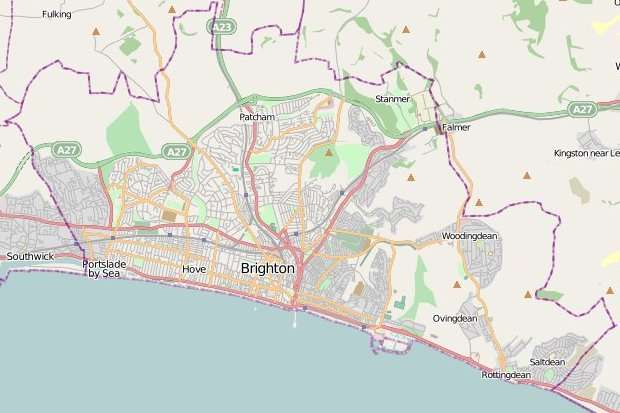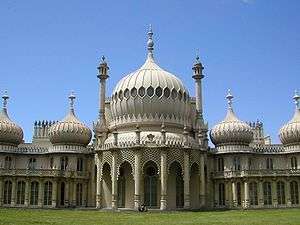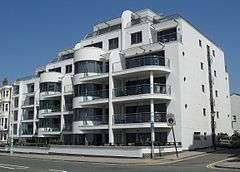Patcham Pylon
The Patcham Pylon is a monumental gateway erected in 1928 near Patcham in East Sussex, England. Designed by local architect John Leopold Denman and paid for by public subscription, it commemorated the extension of the County Borough of Brighton on 1 April 1928, and stood close to the new northern boundary.
| Patcham Pylon | |
|---|---|
%2C_Patcham_(from_SW).jpg) The structures from the southwest | |
| Location | A23 (London Road), Patcham, Brighton and Hove, England |
| Coordinates | 50.88059°N 0.16526°W |
| Founded | 1928 |
| Built | 1928 |
| Built for | Sir Herbert Carden on behalf of the Borough of Brighton |
| Architect | John Leopold Denman |
| Governing body | Brighton and Hove City Council |
Listed Building – Grade II | |
| Official name: East Pylon; West Pylon; Seat next to East Pylon; Seat next to West Pylon | |
| Designated | 26 August 1999 |
| Reference no. | 1381679; 1381681; 1381680; 1381682 |
 Location within the city of Brighton and Hove | |
The gateway consists of two stone towers known locally as "the Pylons", with built-in seats around their bases. They still stand and are clearly visible to travellers on either carriageway of the A23 road to London. They straddle the southbound carriageway of the A23 just outside the city of Brighton and Hove and are individually listed at Grade II.[1][2]
History and symbolic role
The Pylon was built as a symbolic gateway to Brighton and was intended to extend a welcome to travellers approaching from the north along the A23. They were commissioned by Sir Herbert Carden, a local councillor, and were unveiled on 30 May 1928.[3] He paid £2,255 towards them, and the public raised a further £993. They stand either side of what was, at the time of construction, a single carriageway road. Because the road is now a dual carriageway, one pylon now "stands forlornly in the central reservation, although a third is planned".[4]
In the spirit of welcome, the north face of the western tower bears the inscription:[3]
HAIL GUEST• WE ASK NOT WHAT THOU ART.
IF FRIEND. WE GREET THEE. HAND & HEART:
IF STRANGER. SUCH NO LONGER BE:
IF FOE. OUR LOVE SHALL CONQUER THEE.
The pylons and seats were listed at Grade II by English Heritage on 26 August 1999. Such buildings are considered to be "of special interest warranting every effort to preserve them", and "nationally important" buildings of "special interest".[5] As of February 2001, they were among 1,124 Grade II-listed buildings and structures, and 1,218 listed buildings of all grades, in the city of Brighton and Hove.[6]
Architecture
The pylons are of limestone with slightly concave north and south faces. Small buttresses protrude at the corners. Carvings and inscriptions include the coat of arms of the Duke and Duchess of York, who laid the foundation stone, the emblems of Brighton and Sussex, a female figure and a galleon. Details of the date, architect, builders, founders and other descriptive information, and a short poem, are also carved on the flat panels which are mounted on the concave faces.[1][2][3][7] Next to each pylon is a seat, also made of stone and wrapping around but not touching the base. They are about 3 1⁄2 feet (1.1 m) off the ground, supported on small columns, and have decorative moulding. They are separately listed at Grade II.[8][9]
References
- Historic England (2011). "East Pylon, London Road, Brighton, Brighton and Hove (1381679)". National Heritage List for England. Retrieved 29 October 2011.
- Historic England (2011). "West Pylon, London Road, Brighton, Brighton and Hove (1381681)". National Heritage List for England. Retrieved 29 October 2011.
- "The Pylons". Public Sculptures of Sussex Database. University of Brighton. Retrieved 25 October 2011.
- Seldon 2002, p. 73.
- "Listed Buildings". English Heritage. 2010. Archived from the original on 24 January 2013. Retrieved 26 October 2011.
- "Images of England — Statistics by County (East Sussex)". Images of England. English Heritage. 2007. Archived from the original on 27 December 2012. Retrieved 27 December 2012.
- Antram & Morrice 2008, p. 25.
- Historic England (2011). "Seat next to East Pylon, London Road, Brighton, Brighton and Hove (1381680)". National Heritage List for England. Retrieved 29 October 2011.
- Historic England (2011). "Seat next to West Pylon, London Road, Brighton, Brighton and Hove (1381682)". National Heritage List for England. Retrieved 29 October 2011.
Bibliography
- Antram, Nicholas; Morrice, Richard (2008). Brighton and Hove. Pevsner Architectural Guides. London: Yale University Press. ISBN 978-0-300-12661-7.CS1 maint: ref=harv (link)
- Seldon, Anthony (2002). Brave New City: Brighton & Hove Past, Present and Future. Lewes: Pomegranate Press. ISBN 0-9542587-1-1.CS1 maint: ref=harv (link)
| Wikimedia Commons has media related to Patcham Pylons. |

.jpg)
.jpg)
